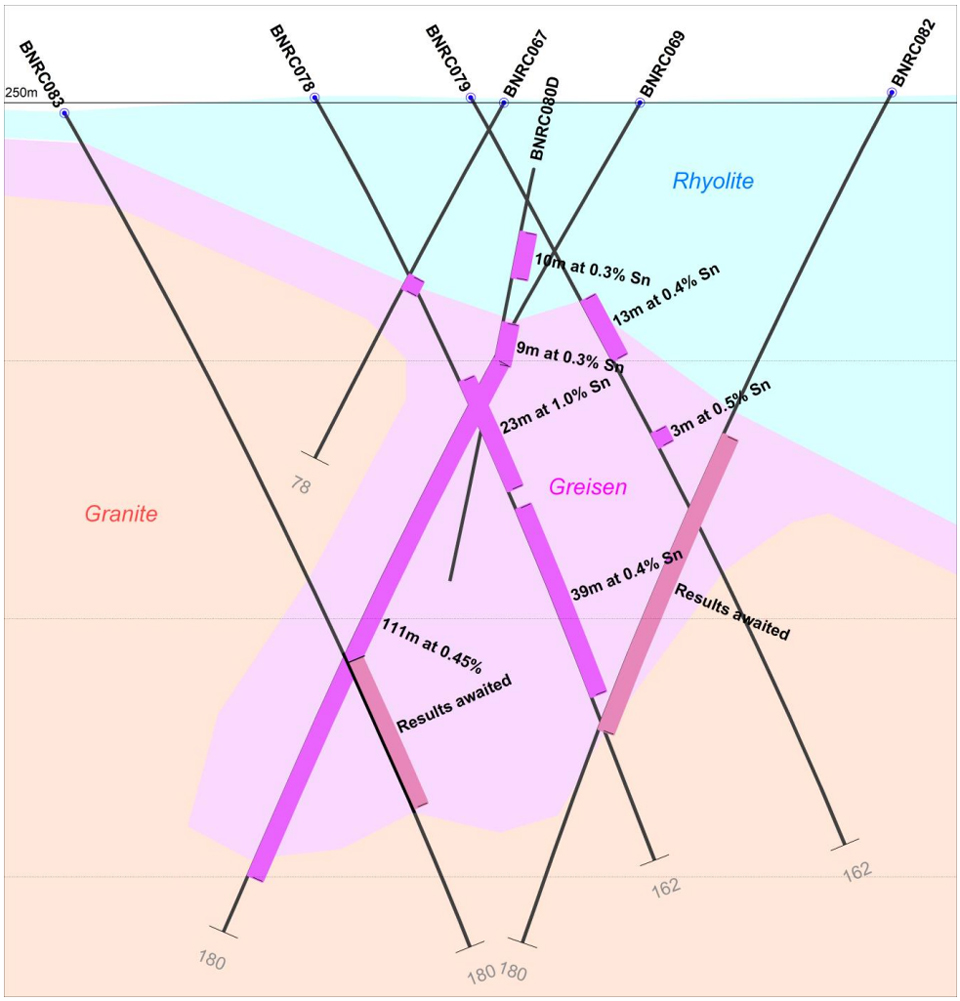Bygoo Tin Project – NSW
Overview
The Bygoo Tin Project surrounds the major tin deposit at Ardlethan which was mined until 1986 with over 31,500 tonnes of tin being produced (reference Paterson, R.G., 1990, Ardlethan tin deposits in the Australasian Institute of Mining and Metallurgy Monograph no. 14, pages 1357-1364). There are several early-twentieth century shallow tin workings scattered up to 10km north and south of Ardlethan, and few have been tested with modern exploration. Thomson has had immediate success in drilling near two of the historic workings, Bygoo North and South, which lie towards the northern end of the tin-bearing Ardlethan Granite.
Exploration Activities
Thomson has completed multiple successful drill programs at the Bygoo Tin Project producing multiple new tin discoveries. A major new tin discovery was made in 2021 300m to the north-west of the main area of drilling. Within a broad zone – 118m at 0.43% Sn from 57m depth – several higher-grade zones occur in BNRC69 including 19m at 1.0% Sn from 87m. The higher-grade zone contains intervals of quartz rich, tourmaline absent greisen as well as the more common tourmaline bearing greisen.
The geometry of this zone is unknown, but it occurs in the cropped paddock, 60m northeast of a line of shallow old workings now reclaimed by bushland. An initial hole, BNRC67, was drilled to test the strike extension of these workings and yielded a weak tourmaline bearing greisen at the target contact of the Ardlethan Granite intrusive contact into older rhyolite with just 3m at 0.1% Sn. Given the presence of strong greisen a decision was made to drill a second hole, BNRC69, to the north-west to make sure the strike extension was fully tested, and this resulted in the discovery.
A further new tin discovery was also made in the same 2021 program just 50m north of the Main Zone with intersections in two holes, BNRC65D – 2.4m at 0.6% Sn and BNRC73 – 23m at 1.4% Sn. These holes were originally designed to test the Main Zone itself. However, partially due to hole deviation, it actually tested areas further north. An old hole, P380, dating from 1975 drilling by Cominco, had an intersection in this general area – 18m at 0.5% Sn – but its location could not be verified. The new “P380” greisen appears to be parallel and offset to the Main Zone.
Results have been received from the 2022 drill program with the first batch of assays covering the first 5 holes at the new discovery at “Stewarts”, 300m NW of the Main Zone. The holes were following up an intersection of 111m at 0.45% Sn from 57m depth in BNRC69.
Wide tin intercepts were made of similar tenor to the intersection in BNRC69, such as 17m at 0.9% Sn from 129m depth in BNRC75; 23m at 1.0% Sn from 62m depth and 39m at 0.4% Sn from 89m depth in BNRC78; 13m at 0.4% Sn from 45m depth in BNRC79.
Three further batches of assays are still in the laboratories for assay. Results expected in H2 of 2022.


